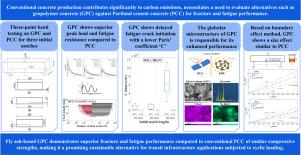缺口地聚合物与普通混凝土梁断裂疲劳性能的试验与统计比较
IF 5.6
2区 工程技术
Q1 ENGINEERING, MECHANICAL
引用次数: 0
摘要
传统混凝土的可持续替代品正受到越来越多的关注,粉煤灰基地聚合物混凝土(GPC)正成为一种有前途的材料,因为它具有降低碳足迹和改善机械性能的潜力。然而,现有的研究缺乏对普通粉煤灰基GPC与PCC在相似抗压强度下的断裂和疲劳行为的详细比较。本研究通过对三种不同初始缺口长度的缺口三点弯曲试件进行静载和循环加载试验,研究并比较了具有相同抗压强度(M25)的粉煤灰基普通GPC与普通波特兰水泥基普通水泥混凝土(PCC)的断裂和疲劳性能。结果表明,GPC比PCC具有更好的断裂和疲劳性能,承受更多的载荷循环。分析表明,经尺寸调整后的GPC裂纹扩展系数C明显低于PCC。然而,两种材料都表现出相似的裂纹扩展指数m。显微组织分析表明,GPC的断裂和疲劳性能的增强与其球球状三维显微组织和元素组成有关。统计分析进一步证实了GPC在不同裂纹扩展阶段的性能优于PCC,其变异性表现为单调加载时的对数均匀分布和循环加载时的Beta分布。此外,应用预测边界效应方法(BEM)证实了GPC中存在尺寸效应。这项研究的结果表明,GPC可以作为一种更耐用和可持续的交通基础设施材料,如道路、桥梁和铁路枕木承受循环载荷。本文章由计算机程序翻译,如有差异,请以英文原文为准。

Experimental and statistical comparison of fracture and fatigue performance of notched geopolymer and conventional concrete beams
Sustainable alternatives to conventional concrete are gaining attention, and fly ash-based geopolymer concrete (GPC) is emerging as a promising material because of its potential for a lower carbon footprint and improved mechanical performance. However, existing studies lack detailed comparison of fracture and fatigue behavior of plain fly ash-based GPC with PCC at similar compressive strengths. This study investigates and compares the fracture and fatigue performance of fly ash-based plain GPC with ordinary Portland cement-based plain cement concrete (PCC) having the same compressive strength (M25) by conducting experiments on notched three-point bend specimens with three different initial notch lengths under static and cyclic loading. The results indicate that GPC demonstrates superior fracture and fatigue performance, withstanding more load cycles than PCC. The analysis reveals that the crack growth coefficient of the size adjusted Paris’ law for GPC is significantly lower than that of PCC. However, both materials exhibit a similar crack growth exponent . Microstructural analysis suggests that GPC’s enhanced fracture and fatigue performance is linked to its spheroidal globular type three dimensional microstructure and its elemental composition. Statistical analysis further confirms the superior performance of GPC over PCC at different stages of crack growth, with its variability best captured by log-uniform distribution in monotonic loading and Beta distribution in cyclic loading. Furthermore, the application of a predictive boundary effect method (BEM) confirmed the existence of a size effect in GPC. The findings of this study suggest that GPC could serve as a more durable and sustainable material for transit infrastructure such as roads, bridges, and rail sleepers subjected to cyclic loads.
求助全文
通过发布文献求助,成功后即可免费获取论文全文。
去求助
来源期刊

Theoretical and Applied Fracture Mechanics
工程技术-工程:机械
CiteScore
8.40
自引率
18.90%
发文量
435
审稿时长
37 days
期刊介绍:
Theoretical and Applied Fracture Mechanics'' aims & scopes have been re-designed to cover both the theoretical, applied, and numerical aspects associated with those cracking related phenomena taking place, at a micro-, meso-, and macroscopic level, in materials/components/structures of any kind.
The journal aims to cover the cracking/mechanical behaviour of materials/components/structures in those situations involving both time-independent and time-dependent system of external forces/moments (such as, for instance, quasi-static, impulsive, impact, blasting, creep, contact, and fatigue loading). Since, under the above circumstances, the mechanical behaviour of cracked materials/components/structures is also affected by the environmental conditions, the journal would consider also those theoretical/experimental research works investigating the effect of external variables such as, for instance, the effect of corrosive environments as well as of high/low-temperature.
 求助内容:
求助内容: 应助结果提醒方式:
应助结果提醒方式:


